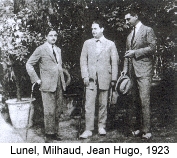|
||||
|
Home | Composers | LES MALHEURS D'ORPHÉE (The Misfortunes of Orpheus) | ESTHER DE CARPENTRAS [Esther of Carpentras]| |
||||
|
The Esther of Carpentras - historical background Carpentras is the former capital of the Comtat Venaissin; the Comtat (county) was ceded to the Popes in 1229, and remained a papal enclave until its annexation in 1791 by decree of the National Assembly - which also took over the adjacent but historically more prominent enclave, the Comtat d'Avignon. Carpentras goes back a very long way. In the 5th century BC it was the capital of a Celtic tribe. The Greeks came to buy honey, wheat, goats and skins, the Romans followed and established a base there - leaving, among other things, an Arch of Triumph with depictions of chained prisoners. For some while in the 14th century, the Popes of Avignon had their residence in Carpentras. The palace of the Papal Legate was built next to the Cathedral in 1640. During the Medieval Inquisition, the Papacy arranged for the two Comtats to provide sanctuaries for Jews - a tradition continued throughout the centuries-long Spanish Inquisition. As sacred and privileged communities (identified by yellow hats) the Sephardi Jews of Carpentras, Avignon, Cavaillon and the Ile-sur Sorgue contributed much to the culture and languages of the Midi, and enjoyed advantages and prosperity beyond the imagining of their contemporaries in Northern and Eastern Europe. But the understandings between Gentile and Jew in Carpentras were as much utilitarian as philosophical, religious, or ethical. In these remote outposts of Rome, the Church's material requirements were often extravagant and always greatly in excess of internal resources. The Jewish communities on the other hand, were skilled and hard-working, and commercially talented. They created 'wealth' and the Catholics taxed it heavily but not punitively. The wealthier Jews were given to understand that the Catholic authorities expected a regular supply of munificent 'gifts'. For their part, the Jewish minorities recognized that in the circumstances the taxes and 'gifts' were a price worth paying in return for protection and even, now and again, grudging respect. Thus the two communities managed to rub along together. Among the traditional Christmas carols of the Comtats which Milhaud's friend and collaborator Armand Lunel collected were some whose verses alternate between the two faiths, each happily at odds with the other. But the story was not without its dark side (as Lunel shows in the history of the Languedoc and Provençal Jews which he published two years before his death). Jews who had been persuaded or bribed to convert were made to walk in chains through Carpentras's Roman Arc de Triomphe to the nearby Cathedral, where they were unshackled and baptised. Milhaud, Lunel, and the Midi Both born in Aix-en-Provence and both with ancient family roots in the Midi - in Carpentras especially - Milhaud and Lunel were exact contemporaries and had been friends from their first school-days. They felt themselves to be part of an unbroken history of Jewish life in Provence and the Languedoc that stretched back to the arrival of the first Jewish settlers six centuries before Christ. It was not as impoverished fugitives from persecution that those distant pioneers and their prosperous successors arrived, but as developers and beneficiaries of the Mediterranean trade routes. In that regard the respective families of Milhaud and Lunel were typical and typically complementary. While Milhaud's father continued in the family business as almond grower and broker - Aix had been the centre of the world's almond trade for centuries - Lunel's was similarly active in the olive business. In the early years there was a third friend, slightly older than Milhaud and Lunel and already recognised as a highly promising poet and writer: Léo Latil, who was a Catholic by upbringing and conviction. Latil was responsible for introducing Milhaud to Paul Claudel, Francis Jammes, and André Gide. His death on the Western | ||||
